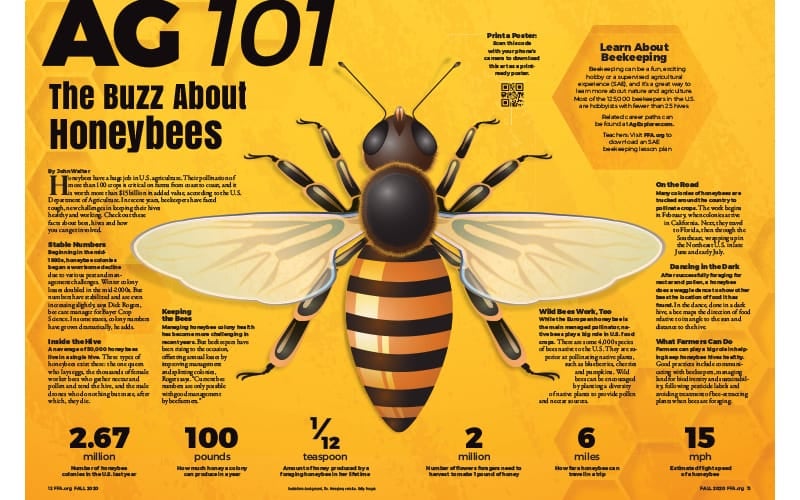Download a print-ready “Ag 101: The Buzz About Honeybees” infographic!
Honeybees have a huge job in U.S. agriculture. Their pollination of more than 100 crops is critical on farms from coast to coast, and it is worth more than $15 billion in added value, according to the U.S. Department of Agriculture. In recent years, beekeepers have faced tough, new challenges in keeping their hives healthy and working. Check out these facts about bees, hives and how you can get involved.
Stable Numbers
Beginning in the mid- 1980s, honeybee colonies began a worrisome decline due to various pest and management challenges. Winter colony losses doubled in the mid-2000s. But numbers have stabilized and are even increasing slightly, says Dick Rogers, bee care manager for Bayer Crop Science. In some states, colony numbers have grown dramatically, he adds.
Inside the Hive
An average of 50,000 honeybees live in a single hive. Three types of honeybees exist there: the one queen who lays eggs, the thousands of female worker bees who gather nectar and pollen and tend the hive, and the male drones who do nothing but mate, after which, they die.
Keeping the Bees
Managing honeybee colony health has become more challenging in recent years. But beekeepers have been rising to the occasion, offsetting annual losses by improving management and splitting colonies, Rogers says. “Current bee numbers are only possible with good management by bee farmers.”
Wild Bees Work, Too
While the European honeybee is the main managed pollinator, native bees play a big role in U.S. food crops. There are some 4,000 species of bees native to the U.S. They are superior at pollinating native plants, such as blueberries, cherries and pumpkins. Wild bees can be encouraged by planting a diversity of native plants to provide pollen and nectar sources.
On the Road
Many colonies of honeybees are trucked around the country to pollinate crops. The work begins in February, when colonies arrive in California. Next, they travel to Florida, then through the Southeast, wrapping up in the Northeast U.S. in late June and early July.
Dancing in the Dark
After successfully foraging for nectar and pollen, a honeybee does a waggle dance to show other bees the location of food it has found. In the dance, done in a dark hive, a bee maps the direction of food relative to its angle to the sun and distance to the hive.
What Farmers Can Do
Farmers can play a big role in helping keep honeybee hives healthy. Good practices include communicating with beekeepers, managing land for biodiversity and sustainability, following pesticide labels and avoiding treatment of bee-attracting plants when bees are foraging.
Bee Basics
- 67 million: Number of honeybee colonies in the U.S. last year
- 1/12 teaspoon: Amount of honey gathered by a foraging honeybee in her lifetime
- 100 pounds: How much honey a colony can produce in a year
- 2 million: Number of flowers foragers need to harvest to make 1 pound of honey
- 6 miles: How far a honeybee can travel in a trip
- 15 mph: Estimated flight speed of a honeybee
- 6 weeks: How long a worker, female bee can live during summer, its busiest time
Learn About Beekeeping
Beekeeping can be a fun, exciting hobby or a supervised agricultural experience (SAE), and it’s a great way to learn more about nature and agriculture. Most of the 125,000 beekeepers in the U.S. are hobbyists with fewer than 25 hives.
Related career paths can be found at AgExplorer.com.
Teachers: Download an SAE beekeeping lesson plan.












